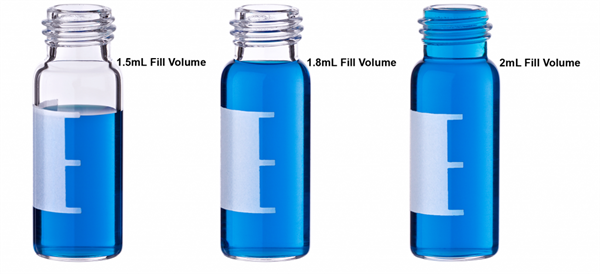What Does "2mL Vial" Really Mean? Understanding Vial Volumes
If you're new to chromatography or lab work, the way vial volumes are described can be a little confusing. Let’s break it down so it’s easy to understand.
🧪 What Does “a 2mL Vial” Actually Mean?
When a vial is labeled as 2mL, that refers to the total volume the vial can hold when it’s completely filled to the top—with no space left once the cap is on. This is called the total fill volume.
But in real lab use, you should not fill the vial all the way to the top. Why? Because when the autosampler needle goes into the vial to draw the sample, it needs a little bit of air space (headspace) to avoid problems.
⚠️ Why You Shouldn’t Fill to 2mL
If the vial is overfilled:
- The needle may not be able to displace the liquid properly.
-
This can cause vapor lock or pressure issues, which may lead to:
- Inaccurate sample draws
- Failed injections
- Poor reproducibility (%RSD errors)
That’s why we recommend using about 1.5mL as the practical or usable volume in a 2mL vial.
📏 What Is “Nominal Volume”?
You might also hear the term nominal volume. This just means the stated or labeled volume (like 2mL), but it doesn’t always match the exact amount you should use. It’s more of a general guideline.
💡 Tips for Better Results
- Use 1.5mL or less in a 2mL vial to allow for proper headspace.
- Check your autosampler’s needle depth—some go deeper than others.
- Slow down the needle draw speed if your sample is thick (viscous). Drawing too fast can cause the needle to pull in air or only partially fill, leading to inaccurate results.
As shown above the Volume of a 12x32 mm screw vial when completely filled, it will contain approximately 2mL. This volume for Autosampler filling is called a total fill volume. When other volume designations are used, this is called a nominal volume.
If ials are overfilled, when the autosampler needle is inserted, it may not have the headspace volume that is necessary to remove and displace liquid. This may cause a pressure differential function (i.e. vapor lock, partial vapor lock, or instantaneous pressurization during penetration) condition or alignment issue. By the needle not having air to displace the solution, the autosampler needle may not be allowed to draw the correct amount of Sample. This can lead to failed %RSD values in peak amount.
Note: It is also prudent to check the method’s needle aspiration speed to ensure that it is not too high. Viscous samples require a lower draw speed or else a partial fill may occur, which may also lead to inaccurate measurements.

